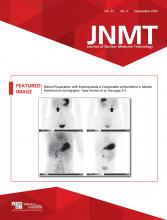RATIONALE
Treating and managing metastatic breast cancer can be challenging for breast oncologists and their patients. Estrogen receptors (ERs) in a patient’s primary tumor can be either estrogen-positive or estrogen-negative to varying degrees or absent on initial biopsy, but this can change if the primary tumor starts to metastasize elsewhere in the body, making treatment decisions difficult. Whole-body imaging with 18F-fluoroestradiol (Cerianna; GE Healthcare) is like performing a whole-body biopsy on the patient, helping to localize ER-positive tumors anywhere in the body (1,2). Knowing where and how many ER-positive tumors are in the body can help breast oncologists and their patients make more accurate management decisions, potentially leading to better outcomes.
CLINICAL INDICATIONS
18F-fluoroestradiol injection is a radioactive diagnostic agent indicated for use with PET imaging for the detection of ER-positive lesions as an adjunct to biopsy in patients with recurrent or metastatic breast cancer.
CONTRAINDICATIONS
There are no contraindications. However, knowing when other recent nuclear medicine studies have been performed (radiopharmaceutical-dependent) can be helpful to ensure the highest-quality 18F-fluoroestradiol PET scan with no interference from any other radiopharmaceutical.
PATIENT PREPARATION AND EDUCATION
If the patient is of childbearing age, a pregnancy test should be performed.
The patient should be instructed to drink water to ensure adequate hydration before administration of 18F-fluoroestradiol.
The patient should be instructed not to take drugs that block the ER or reduce the uptake of 18F-fluoroestradiol (Table 1). Indicated therapy should not be delayed in order to administer 18F-fluoroestradiol.
Patients should be imaged with 18F-fluoroestradiol before starting systemic endocrine therapies that block the ER (e.g., ER modulators and ER downregulators).
A through patient history should be obtained, to include…
○ Current medications and when taken last.
○ Recent imaging procedures (e.g., CT, MRI, PET, and SPECT).
Patient education should include a careful explanation of the procedure, including imaging time, the initial uptake period, and the importance of remaining still during image acquisition. If the patient has severe anxiety or may have difficulty lying still for the procedure, sedation may be used and administered per institutional guidelines.
Medication to Withhold Before 18F-Fluoroestradiol Imaging
PROTOCOL/ACQUISITION INSTRUCTIONS
The patient is interviewed, an intravenous catheter is placed, and the 18F-fluoroestradiol dose is injected (111–222 MBq [3–6 mCi]) over 1–2 min followed by a 10-mL saline flush to ensure proper dose delivery. It is preferred that 18F-fluoroestradiol be injected in the arm contralateral to the primary tumor site. 18F-fluoroestradiol may be diluted with a 0.9% sodium chloride injection. After the injection, the catheter is removed, and the patient is instructed to return for imaging 20–80 min later. The patient may eat and should be encouraged to hydrate and void the urinary bladder frequently during the first hours after administration to reduce radiation exposure. Table 2 outlines the radiopharmaceutical, recommended dose, uptake time, and PET scanner acquisition time.
After the uptake period, the patient is instructed to void the urinary bladder and then is positioned supine on the imaging table with the arms above the head if possible. The use of a body strap, knee cushion, and blanket is recommended to increase patient comfort. Table 3 summarizes the acquisition parameters.
Radiopharmaceutical, Recommended Dose, Uptake Time, and PET Scanner Acquisition Time
Acquisition Parameters
IMAGE PROCESSING
The raw data are reviewed for image quality and motion. If significant motion is detected, making the scan unreadable, a repeat scan is acquired.
The basic processing parameters should follow the 18F-FDG PET/CT procedure standards of the Society of Nuclear Medicine and Molecular Imaging.
WARNINGS AND PRECAUTIONS
Limitations of use: tissue biopsy should be used to confirm recurrence of breast cancer and to verify ER status by pathology. 18F-fluoroestradiol is not useful for imaging other receptors, such as human epidermal growth factor receptor 2 and the progesterone receptor.
Risk of misdiagnosis
○ Tumor characterization may be inadequate, and there may be other ER-positive pathology. Breast cancer may be heterogeneous within patients and across time. 18F-fluoroestradiol images ERs and is not useful for imaging other receptors such as human epidermal growth factor receptor 2 and progesterone receptor.
○ Uptake of 18F-fluoroestradiol is not specific for breast cancer and may occur in a variety of ER-positive tumors that arise outside the breast, including from the uterus and ovaries.
○ 18F-fluoroestradiol should not be used in lieu of biopsy when biopsy is indicated in patients with recurrent or metastatic breast cancer.
○ A negative 18F-fluoroestradiol scan may be false-negative and does not rule out ER-positive breast cancer. Pathology or clinical characteristics that suggest a patient may benefit from systemic hormone therapy should take precedence over a discordant negative 18F-fluoroestradiol scan.
Use in specific populations
○ Pregnancy: a pregnant woman should be advised of the potential risks of fetal exposure to radiation doses with 18F-fluoroestradiol.
○ Lactation: a lactating woman should be advised to avoid breastfeeding for 4 h after 18F-fluoroestradiol administration.
○ Geriatric use: clinical studies with 18F-fluoroestradiol did not reveal any difference in pharmacokinetics or biodistribution in patients aged 65 y or over.
The most common adverse reactions are injection-site pain and dysgeusia.
If sedation is used and the patient traveled to the appointment by car, an accompanying adult should drive the patient home.







